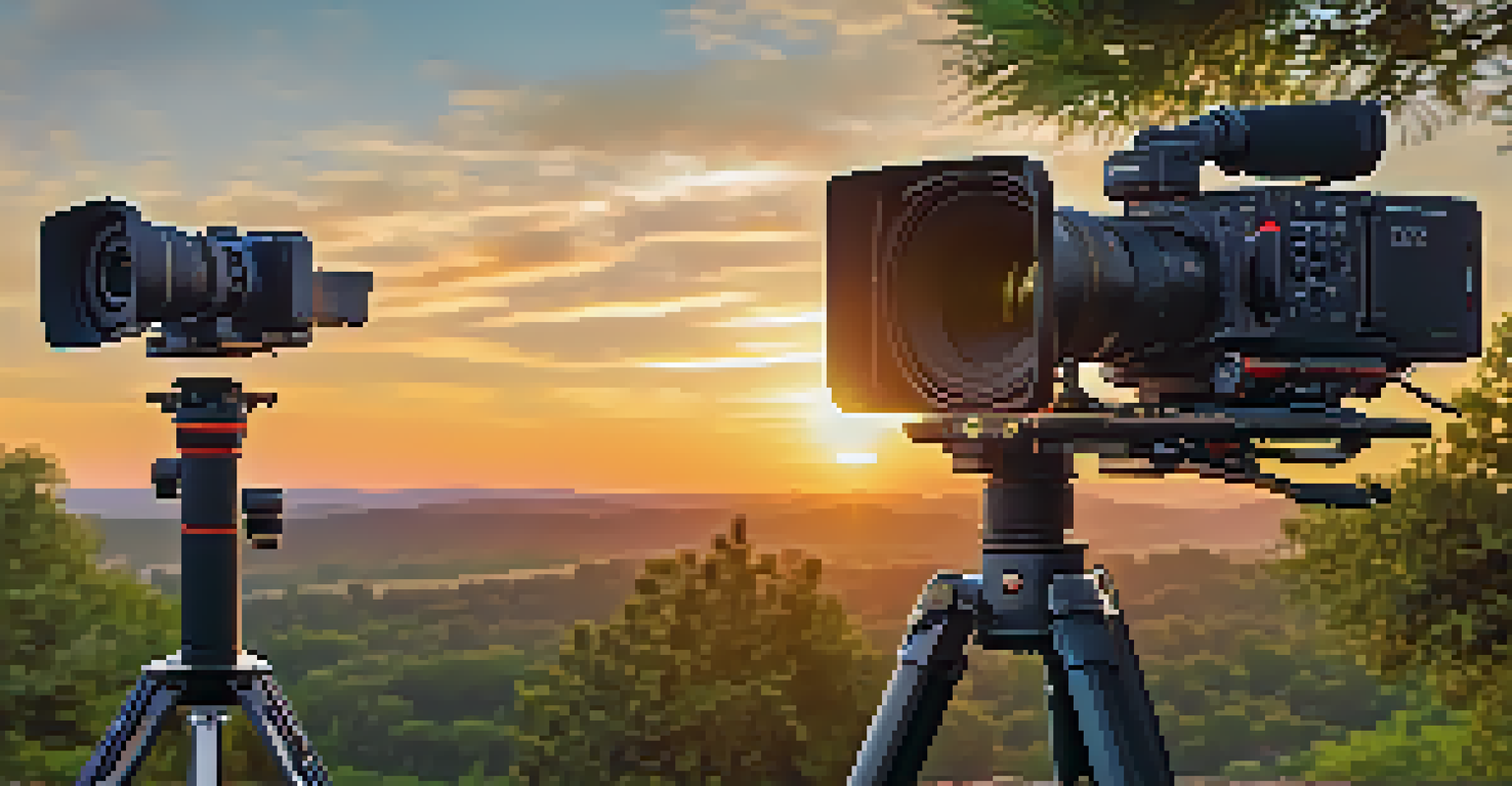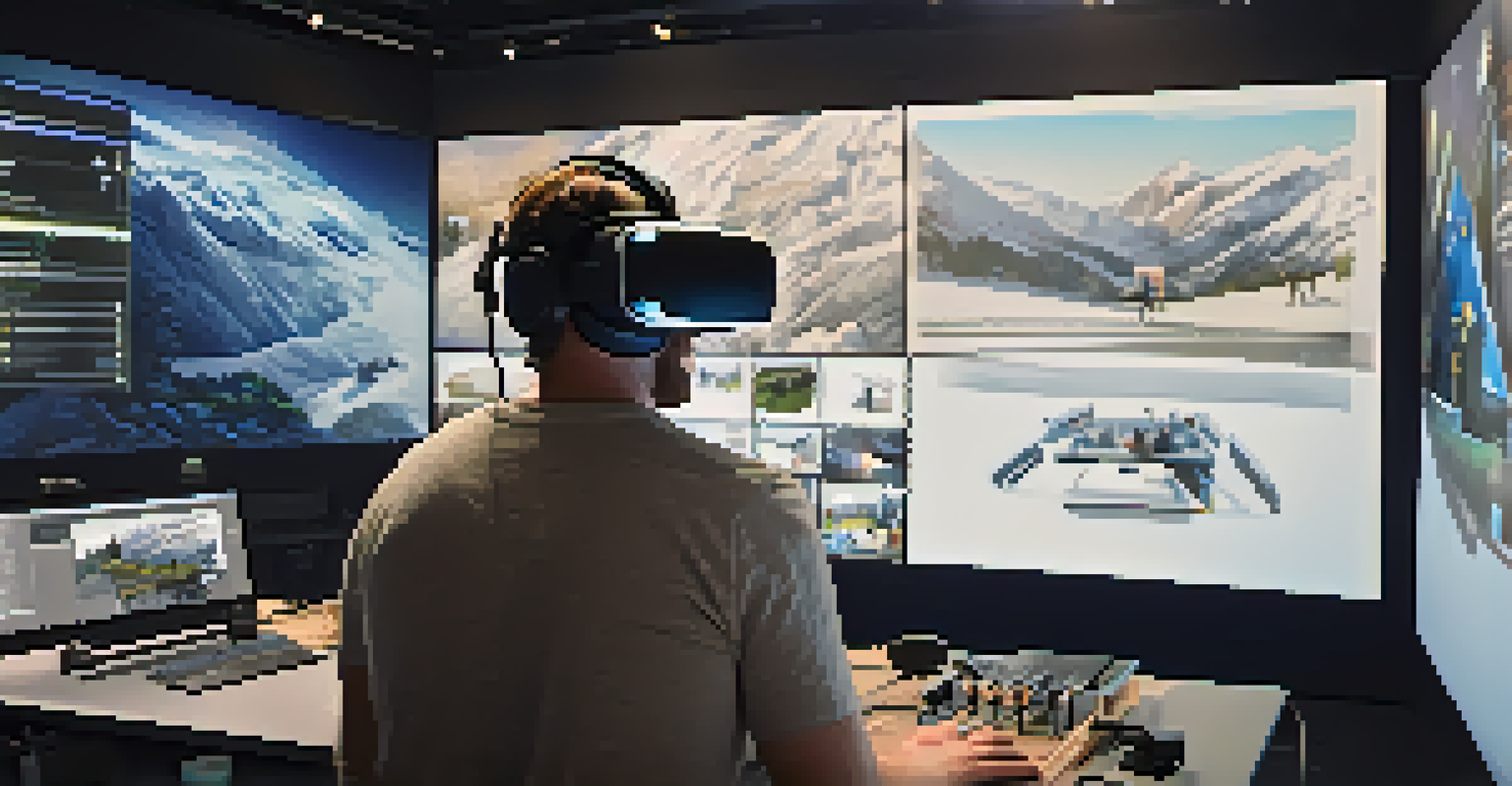Cinematography Evolution: From Film to Digital in the 21st Century

The Birth of Cinematography: A Historical Overview
Cinematography began in the late 19th century, marking a revolutionary shift in storytelling. Early films relied on simple cameras and manual techniques, capturing fleeting moments in time. As technology progressed, filmmakers began experimenting with various methods, including lighting and camera angles, to enhance visual narratives. This laid the groundwork for what would become an art form in its own right, forever changing how stories are told.
The art of cinematography is to capture the essence of the story in a way that resonates with the audience.
The introduction of color film in the 1930s added another layer to this evolving art. Filmmakers now had the power to evoke emotions and convey themes through color choices, elevating the viewing experience. Iconic films from this era, like 'The Wizard of Oz,' showcased the potential of color in storytelling, capturing audiences' imaginations and setting the stage for future innovations.
As we transitioned into the late 20th century, advancements such as zoom lenses and steadicams further refined the craft. These innovations allowed cinematographers to explore new possibilities in framing and movement, pushing the boundaries of creativity. In essence, this period laid the essential groundwork for the digital revolution that was just around the corner.
The Digital Revolution Begins: A Game Changer
The 21st century heralded a monumental shift with the rise of digital cinematography. As digital cameras became more affordable and accessible, filmmakers found themselves empowered to create without the constraints of film. This democratization of technology ignited a surge of creativity, leading to diverse storytelling from a wide range of voices and perspectives.

Digital cinematography offered significant advantages, including immediate playback and the ability to shoot in low-light conditions. Filmmakers could now experiment more freely, eliminating the fear of wasting costly film stock. This shift not only changed the way films were made but also how they were distributed and consumed, with digital platforms proliferating.
Cinematography's Rich Evolution
Cinematography has evolved from simple manual techniques in the late 19th century to sophisticated digital innovations, transforming storytelling in film.
However, the transition from film to digital was not without its challenges. Many traditionalists were hesitant to embrace this new medium, concerned about the loss of the tactile experience of film. Yet, as the quality of digital imaging improved dramatically, it became clear that digital cinematography was here to stay.
Technological Advancements in Digital Cinematography
With the digital landscape constantly evolving, filmmakers have access to an array of advanced tools. High-definition cameras, drones, and 360-degree filming have transformed how stories are captured. These innovations enable cinematographers to craft visually stunning narratives that were once unimaginable, pushing the boundaries of creativity.
Digital technology has democratized filmmaking, allowing more voices to tell their stories.
Moreover, software advancements in post-production have revolutionized editing and visual effects. Programs like Adobe Premiere Pro and DaVinci Resolve allow for intricate manipulation of color and light, giving filmmakers total control over their vision. This level of precision not only enhances storytelling but also allows for a more immersive viewer experience.
Additionally, the rise of virtual reality (VR) and augmented reality (AR) is opening up new dimensions in cinematography. Filmmakers can now create interactive experiences that engage audiences like never before, blurring the lines between film and reality. This intersection of technology and storytelling is truly a frontier for future filmmakers to explore.
The Art of Cinematography: A Blend of Craft and Technology
Despite the technological advancements, the essence of cinematography remains rooted in artistry. A skilled cinematographer blends technical expertise with creative vision, crafting a visual language that complements the narrative. This delicate balance is what elevates a film from mere visuals to a powerful storytelling experience.
For example, consider how lighting choices can set the mood for a scene. A well-lit scene can evoke warmth and intimacy, while shadows can create tension or mystery. The cinematographer's role is to understand these nuances and harness them effectively, regardless of whether they are working with film or digital.
Digital Revolution's Impact
The rise of digital cinematography has democratized filmmaking, enabling diverse voices and innovative storytelling methods while challenging traditional practices.
Ultimately, the evolution from film to digital has not diminished the artistry of cinematography; instead, it has expanded its possibilities. Filmmakers today can explore diverse techniques and styles, allowing them to push creative boundaries while retaining the core principles of visual storytelling.
Impact on Filmmaking Styles and Genres
The transition to digital cinematography has significantly influenced various filmmaking styles and genres. Independent filmmakers, in particular, have thrived in this new environment. With lower production costs and the ability to shoot on smaller, more portable cameras, they can bring innovative ideas to life without the constraints of traditional filmmaking budgets.
Moreover, genres such as documentary filmmaking have been transformed by digital technology. The ability to shoot with lightweight cameras allows filmmakers to capture raw, unfiltered moments in real-time, creating a sense of authenticity that resonates with audiences. This has made documentaries more engaging and relatable, contributing to their increasing popularity.
In addition, the rise of streaming platforms has changed the landscape of cinematic storytelling. With the demand for varied content, filmmakers are experimenting with shorter formats and unique narrative structures. This shift has paved the way for diverse storytelling that reflects contemporary society, making cinema more inclusive than ever before.
Challenges and Critiques of Digital Cinematography
While digital cinematography has brought many advantages, it is not without its critiques. Some argue that the ease of shooting digitally has led to a decline in the craftsmanship that defined traditional filmmaking. The accessibility of technology can sometimes result in a saturation of content, making it challenging for unique voices to stand out in a crowded marketplace.
Additionally, the reliance on digital effects can sometimes overshadow the importance of practical effects and on-set artistry. Filmmakers must strike a balance between utilizing technology and preserving traditional techniques to maintain the integrity of their work. This ongoing conversation highlights the need for filmmakers to remain grounded in the fundamentals of their craft.
Future of Cinematography
Emerging technologies like artificial intelligence and virtual reality promise to reshape the landscape of cinematography, enhancing audience engagement and interactive storytelling.
Moreover, as digital formats continue to evolve, filmmakers face the challenge of keeping up with ever-changing technology. Staying current requires ongoing learning and adaptation, which can be both exciting and daunting for those in the industry. Navigating these challenges is essential for filmmakers who wish to thrive in this dynamic environment.
The Future of Cinematography: What Lies Ahead
Looking ahead, the future of cinematography is poised for even more exciting developments. As technology continues to evolve, filmmakers will undoubtedly find new ways to tell stories that captivate audiences. Emerging technologies such as artificial intelligence and machine learning have the potential to revolutionize how films are made, from script development to post-production.
Moreover, the integration of immersive technologies like virtual reality could redefine audience engagement. Filmmakers may create experiences where viewers can interact with narratives in ways we are just beginning to understand, pushing the boundaries of traditional storytelling. This evolution promises to create a more participatory and engaging cinematic experience.

As we move forward, the key will be balancing innovation with the artistry that defines cinema. Filmmakers will need to embrace new technologies while remaining true to the storytelling principles that resonate with audiences. This delicate balance will shape the future of cinematography, ensuring that it continues to evolve while maintaining its core essence.